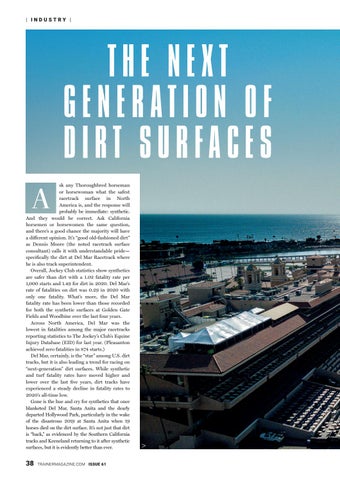| INDUSTRY |
THE NEXT GENERATION OF DIRT SURFACES A
sk any Thoroughbred horseman or horsewoman what the safest racetrack surface in North America is, and the response will probably be immediate: synthetic. And they would be correct. Ask California horsemen or horsewomen the same question, and there’s a good chance the majority will have a different opinion. It’s “good old-fashioned dirt” as Dennis Moore (the noted racetrack surface consultant) calls it with understandable pride— specifically the dirt at Del Mar Racetrack where he is also track superintendent. Overall, Jockey Club statistics show synthetics are safer than dirt with a 1.02 fatality rate per 1,000 starts and 1.49 for dirt in 2020. Del Mar’s rate of fatalities on dirt was 0.29 in 2020 with only one fatality. What’s more, the Del Mar fatality rate has been lower than those recorded for both the synthetic surfaces at Golden Gate Fields and Woodbine over the last four years. Across North America, Del Mar was the lowest in fatalities among the major racetracks reporting statistics to The Jockey’s Club’s Equine Injury Database (EID) for last year. (Pleasanton achieved zero fatalities in 874 starts.) Del Mar, certainly, is the “star” among U.S. dirt tracks, but it is also leading a trend for racing on “next-generation” dirt surfaces. While synthetic and turf fatality rates have moved higher and lower over the last five years, dirt tracks have experienced a steady decline in fatality rates to 2020’s all-time low. Gone is the hue and cry for synthetics that once blanketed Del Mar, Santa Anita and the dearly departed Hollywood Park, particularly in the wake of the disastrous 2019 at Santa Anita when 19 horses died on the dirt surface. It’s not just that dirt is “back,” as evidenced by the Southern California tracks and Keeneland returning to it after synthetic surfaces, but it is evidently better than ever.
38
TRAINERMAGAZINE.COM ISSUE 61
